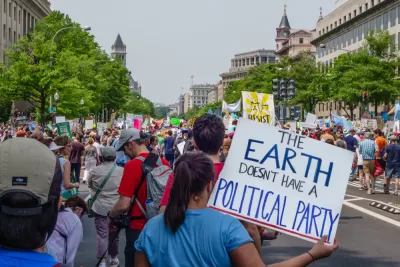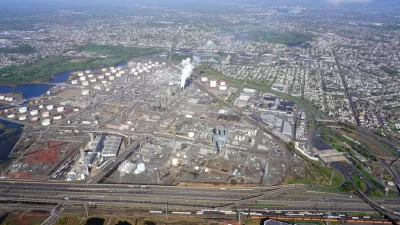How can President Trump, who has made environmental regulation rollbacks and climate denial trademarks of his administration, be expected to select projects for his infrastructure plan that must weather climate change?

The Trump infrastructure plan, expected to be unveiled Monday, hopes to leverage $200 billion to generate $1.5 trillion. In addition to achieving that financial feat, it must consider the outcome of selecting projects should, like the administration, they ignore climate science.
Unlike Trump and many in his cabinet who question the existence of global warming (or think that it is beneficial), infrastructure projects are expected to hold up to weather, which is changing due to climate change.
"The Trump infrastructure blueprint is almost certain to call for expensive new roads, bridges, airports and other projects in areas that are increasingly vulnerable to rising waters and other threats from a warming planet," reports Coral Davenport, who covers energy and environmental policy, with a focus on climate change, for The New York Times, on Feb. 10.
Engineers and researchers say that construction plans should consider these design constraints at the outset
“The impact of not considering climate change when planning infrastructure means you end up building the wrong thing, in the wrong place, to the wrong standards,” said Michael Kuby, a professor of geographical sciences and urban planning at Arizona State University and contributing author to the National Climate Assessment, the federal government’s most comprehensive scientific study of the effect of global warming on the United States. “That’s a whole lot of waste.”
Davenport reports that while U.S. Environmental Protection Agency Administrator Scott Pruitt may deny climate science, a report prepared by his agency last year for the Fourth National Climate Assessment "concluded that, through the end of the century, up to $280 billion will be needed to adapt the nation’s roads and railways to the effects of a warming climate."
It provides analysis showing that “proactive adaptation” — essentially, planning for global warming before you build — could save the government up to 70 percent in future costs of repairing damage caused by climate change-driven weather events such as deluges, coastal flooding and heat waves.
Davenport sites specific infrastructure projects which need to be designed for what the climate is expected to be like in 25 to 50 years.
“If you don’t do that,” said Paul Chinowsky, a professor of civil engineering at the University of Colorado, Boulder, “It could double the cost of maintenance and the amount of delays on that road.”
The situation is similar to planning the rebuilding efforts following Hurricane Harvey last August which occurred a mere two weeks after Trump signed an executive order that gutted "the Obama-era Federal Flood Risk Management Standard, which set higher resiliency standards for projects that receive federal funds and are vulnerable to sea-level rise," according to Planetizen.
Hat tip to Mark Boshnack.
FULL STORY: Trump’s Infrastructure Plan May Ignore Climate Change. It Could Be Costly

Planetizen Federal Action Tracker
A weekly monitor of how Trump’s orders and actions are impacting planners and planning in America.

San Francisco's School District Spent $105M To Build Affordable Housing for Teachers — And That's Just the Beginning
SFUSD joins a growing list of school districts using their land holdings to address housing affordability challenges faced by their own employees.

The Tiny, Adorable $7,000 Car Turning Japan Onto EVs
The single seat Mibot charges from a regular plug as quickly as an iPad, and is about half the price of an average EV.

Seattle's Plan for Adopting Driverless Cars
Equity, safety, accessibility and affordability are front of mind as the city prepares for robotaxis and other autonomous vehicles.

As Trump Phases Out FEMA, Is It Time to Flee the Floodplains?
With less federal funding available for disaster relief efforts, the need to relocate at-risk communities is more urgent than ever.

With Protected Lanes, 460% More People Commute by Bike
For those needing more ammo, more data proving what we already knew is here.
Urban Design for Planners 1: Software Tools
This six-course series explores essential urban design concepts using open source software and equips planners with the tools they need to participate fully in the urban design process.
Planning for Universal Design
Learn the tools for implementing Universal Design in planning regulations.
Smith Gee Studio
City of Charlotte
City of Camden Redevelopment Agency
City of Astoria
Transportation Research & Education Center (TREC) at Portland State University
US High Speed Rail Association
City of Camden Redevelopment Agency
Municipality of Princeton (NJ)





























